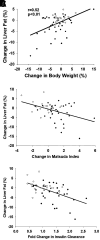Empagliflozin Reduces Liver Fat in Individuals With and Without Diabetes
- PMID: 38295394
- PMCID: PMC10973912
- DOI: 10.2337/dc23-1646
Empagliflozin Reduces Liver Fat in Individuals With and Without Diabetes
Abstract
Objective: To examine the effect of empagliflozin on liver fat content in individuals with and without type 2 diabetes (T2D) and the relationship between the decrease in liver fat and other metabolic actions of empagliflozin.
Research design and methods: Thirty individuals with T2D and 27 without were randomly assigned to receive in double-blind fashion empagliflozin or matching placebo (2:1 ratio) for 12 weeks. Participants underwent 75-g oral glucose tolerance testing and measurement of liver fat content with MRS before therapy and at study end. Hepatic glucose production before the start of therapy was measured with 3-3H-glucose.
Results: Empagliflozin caused an absolute reduction of 2.39% ± 0.79% in liver fat content compared with an increase of 0.91% ± 0.64% in participants receiving placebo (P < 0.007 with ANOVA). The decrease in liver fat was comparable in both individuals with diabetes and those without (2.75% ± 0.81% and 1.93% ± 0.78%, respectively; P = NS). The decrease in hepatic fat content caused by empagliflozin was strongly correlated with baseline liver fat content (r = -0.62; P < 0.001), decrease in body weight (r = 0.53; P < 0.001), and improvement in insulin sensitivity (r = -0.51; P < 0.001) but was not related to the decrease in fasting plasma glucose or HbA1c or the increase in hepatic glucose production.
Conclusions: Empagliflozin is effective in reducing liver fat content in individuals with and without T2D. The decrease in liver fat content is independent of the decrease in plasma glucose concentration and is strongly related to the decrease in body weight and improvement in insulin sensitivity.
© 2024 by the American Diabetes Association.
Conflict of interest statement
Figures



References
-
- Younossi Z, Anstee QM, Marietti M, et al. . Global burden of NAFLD and NASH: trends, predictions, risk factors and prevention. Nat Rev Gastroenterol Hepatol 2018;15:11–20 - PubMed
-
- Polyzos SA, Kountouras J, Mantzoros CS.. Obesity and nonalcoholic fatty liver disease: from pathophysiology to therapeutics. Metabolism 2019;92:82–97 - PubMed
-
- Kojima S, Watanabe N, Numata M, Ogawa T, Matsuzaki S.. Increase in the prevalence of fatty liver in Japan over the past 12 years: analysis of clinical background. J Gastroenterol 2003;38:954–961 - PubMed
Publication types
MeSH terms
Substances
Grants and funding
LinkOut - more resources
Full Text Sources
Medical
Miscellaneous

